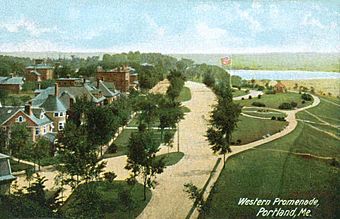Western Promenade facts for kids
Quick facts for kids |
|
|
Western Promenade
|
|

A postcard of the Western Promenade circa 1908
|
|
| Location | Roughly Western Promenade from Maine Medical Center to Valley St., Portland, Maine |
|---|---|
| Area | 18.1 acres (7.3 ha) |
| Built | 1836 |
| Architect | Goodwin, William; Olmsted Brothers |
| NRHP reference No. | 89001710 |
| Added to NRHP | October 16, 1989 |
The Western Promenade is a beautiful public park in Portland, Maine. It's a historic "promenade," which means it's a long, open space perfect for walking. This park is about 18.1 acres (7.3 ha) in size. It was created between 1836 and the early 1900s. The famous Olmsted Brothers helped design its look. They also made a big plan for all of Portland's parks. The Western Promenade was added to the National Register of Historic Places in 1989. This means it's an important historical site.
Contents
About the Western Promenade Park
The Western Promenade park sits on a high bluff. This spot gives amazing views over the western side of the Portland area. To the north, you'll find the Maine Medical Center. To the east, there's the Western Cemetery. There are also many old homes from the 1800s nearby. These homes are part of the Western Promenade Historic District. To the west, the park is next to Valley Street.
The park is long and narrow, covering over 18 acres (7.3 ha) of land. From here, you can see the White Mountains in New Hampshire. The steep hillside below the park is covered in trees. There's a special path near West Street that goes down to Valley Street. Many of the trails you see today were planned by John C. Olmsted in 1905.
How the Park Was Created
The city of Portland started buying land for this park way back in 1836. People always loved the views from this spot. As Portland grew, people wanted more open spaces. So, the city decided to create a park here. At some point, a tree-lined road was built along the bluff.
In the late 1870s, a city engineer named William Goodwin worked hard to make the park even better. Later, in the 1890s and 1900s, Mayor James Phinney Baxter helped make the park bigger. He hired the Olmsted Brothers to design the park's landscape. They also created a big plan for all the parks in the city. John C. Olmsted and Henry Vincent Hubbard helped design the Western Promenade.
The Western Promenade Neighborhood
The name "Western Promenade" also refers to the neighborhood next to the park. In the 1800s, a very rich businessman named John Bundy Brown owned this land. He owned a large factory in Portland. After he passed away, his land was sold in smaller pieces. That's how the neighborhood we see today was built.
This area is home to many large, beautiful houses. These mansions were built for some of Portland's wealthiest families. The Western Promenade Historic District includes many of these historic homes.
Western Promenade Neighborhood Association
The Western Promenade Neighborhood Association started in 1973. This group works to improve and beautify the neighborhood. They also help keep homes safe and protect the area's history and culture. As of 2021, the president of this group was Anne Pringle, who used to be the mayor of Portland.
Gallery
-
A statue of Thomas Brackett Reed, who was a Speaker of the U.S. House of Representatives, on the Western Promenade.





